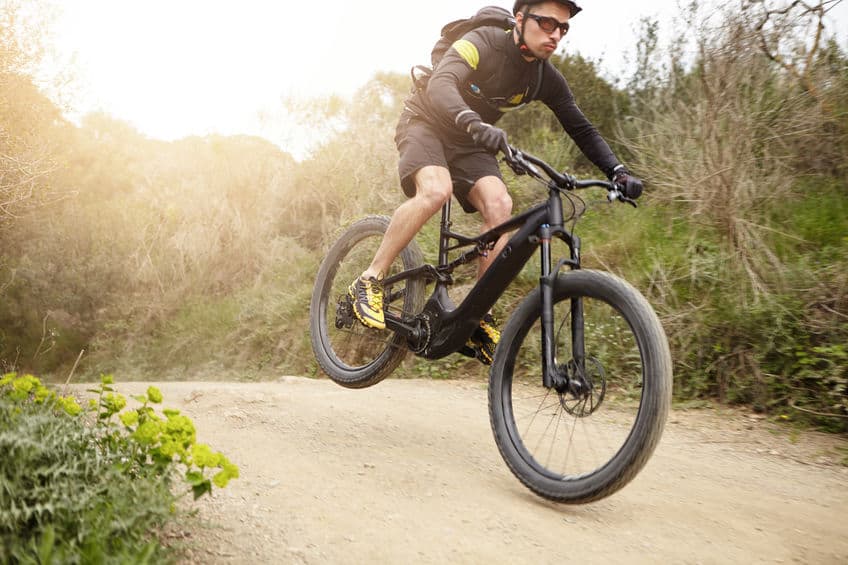It is fairly common knowledge that mountain bikes are very durable, and sometimes that they can even be cheaper than certain brands of road bikes, so perhaps you are thinking about just getting a mountain bike with the goal of having a bike that you can both ride on the cross country trails as well as on the asphalt roads.
Simply put, yes, you can use a mountain bike on a regular road. However, a mountain bike is built somewhat differently than a bike that is specifically made for use on roads is and will likely cost you more energy in order to get where you are trying to go in addition to not being nearly as fast sometimes.
While some of these differences may be obvious just by looking at the two different kinds of bikes, there are other things that you might not have thought of. Knowing what these differences are and how they affect your ride can help you to decide if using your mountain bike as a road bike is really something that you want to do.
What Are The Differences Between Mountain Bikes And Road Bike?
One of the first things that you will likely notice when comparing the two is the difference in the handlebars. Mountain bike handlebars are not only placed much higher up, but they are also wider. This is a great design for mountain bikes for a number of different reasons. Having the handlebars higher up can be a tremendous help when it comes to your balance over bumpy patches of soil.
Wider handlebars are good for your balance too in that they let your arms be further apart. More than this is also the fact that having your arms further apart allows your lungs to expand easier, letting you take deeper, fuller breaths that you will need for the long trails and steep climbs.
Road bikes, on the other hand, are made to be more aerodynamic and have handlebars that are lower down and sometimes almost ridiculously narrow. This is in part because you do not need as much stability from the handlebar, but also when you are biking down the road it is much more important that your handlebars don’t happen to catch anything on either side. Truly though, the aerodynamics is the main reason why road by handlebars are so short and narrow.
The next difference which you might or might not be able to notice is that the gearing is different on these. Mountain bikes have gears are designed to accommodate the steep climbs and the equally steep drops that you have to pedal through. This means that they have a wide difference in the sizes and teeth counts of these gears that lets you sometimes feel a drastic difference when you shift gears here.

Road bikes, to the contrary, do not have to worry about steep inclines either one way or the other. This allows the gears to be closer in size and teeth count, making the change between gears more gradual and it allowa you to adjust you speed in small increments instead of having to shift gears and then immediately play catch up or be jerked to a slower speed.
Down at the wheels, the tires of mountain bikes and road bikes have a couple of main differences of their own. The first of these is the tread of the tire. On mountain bikes this tread is not only extra thick to avoid getting punctures in it, but it also tends to have knobs and other features that help to give it as much grip on the ground as possible.
Tires on road bikes are not being ridden through briar patches or anything like that, and they therefore do not need the thicker tire. They also do not need the same amount of grip that mountain biking tires have. In fact, road bikes most commonly have what are referred to as slick tires that are as smooth as possible and which will cause as little friction with the ground as they possibly can.
The second one of the tire differences has to do with the air pressure which is more commonly referred to as the psi. On a mountain bike you want the psi to be as low as you can get it since this will help keep your rims lower to the ground and will give your tires better grip on the uneven terrain.
Road bikes do not need to have this same level of grip. In fact, they are much more efficient if their tires have as high of a psi as they are allowed to hold. This higher pressure makes the tires stiffer and helps you to have more momentum on the smooth road. This is particularly helpful when you stand on the pedals to power pedal for a while because of the fact that doing so will not push down on your tires too much.
Another one of the major differences between these two different kinds of bikes which goes right along with that is the suspensions. Mountain bikes have amazing suspensions that are very well equipped to take on all of the bumps, jolts, jumps, and everything else that comes along with mountain biking down the rough terrain of the cross country trails. Even though these suspensions can add a bit to the weight, you will rarely see a mountain bike without them.
Road bikes on the other hand pretty much have nothing in the area of suspensions, because they do not need this feature. When riding down a road you may have the occasional pothole, but other than that the asphalt will be really smooth most of the time. This allows a road bike to easily go without suspensions, making them lighter, and therefore faster than they would be with the unnecessary weight.
All in all, mountain bikes are made bigger, tougher, and heavier in order to take whatever the trail dishes out at them without the frame bending or any of the parts breaking on you. Road bikes are built smaller, lighter, and with speed in mind, even to the point of sacrificing the durability of the frame at times.
Conclusion
In spite of the many differences between these two kinds of bikes, mountain bikes are undoubtedly made to be more durable than road bikes are. So if you are looking for a bike that will last you a long time and possibly also withstand a crash or two without getting damaged beyond repair, then getting a mountain bike might very well be the way to go for you even if you are going to be riding on the roads.
Because of the added weight and size of mountain bikes, this means that you will have to push harder on the pedals than you would have to on a lighter road bike. This will translate into taking both more energy as well as into taking you a little more time to get to your destination sometimes.
There is also a very high possibility that the roads you are riding on are far from being smooth due to potholes, bad patch jobs, and any number of other factors. This means that your road may actually have much more in common with a cross country trail than it does with the stereotypical smooth asphalt road that road bikes are designed for.
You also have to take into consideration that there are different kinds of mountain bikes too. The more rough the terrain that a bike is meant to go over – take all mountain or Enduro bikes for example – the more “beefed up” the bike will be and the less suited it will be for ordinary road travel.
However, simpler trail bikes that are made for the smoother trails might actually be the perfect fit for a rough asphalt road. The fact is that you will often see city bike curriers on hardtail trail mountain bikes about just as often if not more often than you will see them on an actual road bike.

